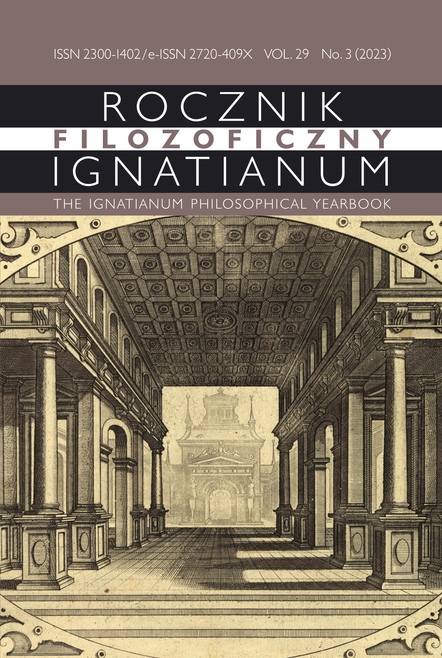The Signs and Symbols Encoded in the “Walencinek” as an Expression of the Uniqueness and Phenomenal Beauty of the St. Valentine’s Sanctuary in Bieruń
Abstract
The aim of the work is to examine the history of the church of St. Valentine in Bieruń in Upper Silesia and define the layers of meaning and symbolism that significantly determine the uniqueness and beauty of the sanctuary. The wooden church belongs to the parish of St. Bartholomew the Apostle, and the first historical mention of its existence comes from 1628. The church, which enshrines the relics St. Valentine, attracts crowds of pilgrims every year. The research method adopted in this study combines the analysis of sacred art with a local historical background and a broader cultural perspective. Its aim is to isolate symbols and signs that determine the uniqueness and beauty of the sanctuary.
References
Baldock John, Symbolika chrześcijańska (Poznań: Dom Wydawniczy „Rebis”, 1994).
Hani Jean, Symbolika świątyni chrześcijańskiej (Kraków: Znak, 1998).
Lasek Grażyna, „Bieruńskie »Genius loci« – szczególny przypadek miejsca węzłowego miasta, w: Budownictwo i Architektura 17 (2018) 3: 005–014.
Lasek Grażyna, „Problematyka piękna a elementy szczególne w krajobrazie – studium przypadków w otoczeniu miasta Bieruń”, w: Piękno w architekturze. Harmonia miejsca, red. Bogusław Szuba, Tomasz Drewniak (Wrocław: Presscom Sp. z o.o., 2021), 179–193.
Lasek Grażyna, „Problematyka piękna w dokumentach Kościoła katolickiego a praktyka architektury sakralnej – wybrane zagadnienia”, w: Piękno w architekturze. Tradycja i współczesność. Realizacje, red. Bogusław Szuba, Tomasz Drewniak (Nysa, Oficyna Wydawnicza PWSZ, 2018), 67–76.
Lasek Grażyna, „Wielki Staw Bieruński – kontekst historii, tradycji, miejsca”, w: Innowacyjne rozwiązania Rewitalizacji Terenów Zdegradowanych, t. 8, red. Jan Skowronek (Katowice: Instytut Ekologii Terenów Uprzemysłowionych, 2016), 223–232.
Marcinek Roman, „Wielki Staw Bieruński i jego pozostałości”, Zeszyty Bieruńskie 30 (1993).
Matuszczak Józef, Z dziejów architektury drewnianej na Śląsku (Bytom: Muzeum Górnośląskie w Bytomiu, 1971).
Musioł Ludwik, BIERUŃ. Miasto, kościół i parafia. Monografia historyczna (Bieruń: Bieruński Ośrodek Kultury, 1999).
Nyga Jerzy, ks., „Pamiątki Przeszłości Bierunia. Kościół Św. Bartłomieja i Kościół Św. Walentego”, Zeszyty Bieruńskie 24 (1981).
Nyga Jerzy, ks., „Pamiątki Przeszłości Bierunia. Zabudowa miejska. Kopiec”, Zeszyty Bieruńskie 11 (1989).
Szymski Adam Maria, Kanon formy architektonicznej w kościele katolickim. Tradycja i współczesność architektury sakrum, „Prace Naukowe Politechniki Szczecińskiej. Instytut Architektury i Planowania Przestrzennego” 496 (2000) 36: 11–587.
Zaczyk Eugeniusz (tekst), Nyga Roman (rysunki) Nyga Jerzy (przekład tekstów na język niemiecki), Stwôrôki. Wizerunki stworoków śląskich (Bieruń: Bieruński Ośrodek Kultury w Bieruniu, 1994).
Katechizm Kościoła Katolickiego (Poznań: Pallottinum, 1994), ust. 2502, 560–561.
Sobór Watykański II Konstytucje Dekrety Deklaracje, Tekst łacińsko-polski (Poznań: Pallottinum, wyd. II, 2002), KL 122, 93.
„Św. Walenty patronem Bierunia”, Rodnia. Dwutygodnik społeczno-kulturalny Bierunia 20 (2004) 4: 1, 16.
Zwiedzamy Bieruń. Odcinek 2 Walencinek. Wystąpił Roman Nyga, scenariusz Agnieszka Szymula, Wiktor Nyga, realizacja Wojciech Wikarek (producent: Muzeum Miejskie w Bieruniu (w organizacji), Miasto Bieruń, https://youtu. be/xvcDGuiC-bU (dostęp: 26.08.2023).
Cirlot Juan Eduardo, Słownik symboli (Kraków: Wydawnictwo Znak, 2000). Lasek Grażyna, Współczesne tendencje w architekturze sakralnej z uwzględnieniem czynników proekologicznych, rozprawa doktorska, promotor prof. dr hab. inż. arch. Adam Lisik (Gliwice: Politechnika Śląska, Wydział Architektury, 2005).
Lurker Manfred, Słownik obrazów i symboli biblijnych (Poznań: Pallotinum, 1989).
Copyright (c) 2023 Jesuit University Ignatianum in Krakow

This work is licensed under a Creative Commons Attribution-NoDerivatives 4.0 International License.
The Yearbook only accepts materials for publication that are free of all conflicts of interest, and that in no way involve conflicts over authorship, copyright, etc. The Editors will take action against any cases of plagiarizing, ghostwriting1, guest/honorary authorship2, etc. Where co-authored work is concerned, the Author listed first is expected to take responsibility for the submission, and is required to make clear the contributions of all of the Co-Authors involved. In the event of the publication owing its existence to funding dedicated to this purpose, this fact should be made clear: e.g. in any note of thanks/acknowledgement, or in a footnote, etc. Explicit notification should be given of any form of reprinting, with the appropriate evidence of permission to publish being furnished as required. Any impropriety on the part of Authors/Reviewers risks exposing them to appropriate responses from the relevant institutions.
______
1 This term refers to instances of a person who has made an essential contribution being omitted from the list of authors, or from notes conveying gratitude and/or acknowledgement.
2 This occurs when a person who has made either an insignificant contribution or no contribution at all nevertheless appears on the list of authors.





